Day 1 – Tequila (The Place, Not the Drink… But Plenty of That Too)
“Road trips with friends are the perfect recipe for adventure, laughter, and unforgettable memories; it’s not just about the destination, but the journey you take together.” – Unknown
“You have to be kidding me,” Chris said as they popped the hood. We were barely out of the clutches of Banderas Bay when Groovy, our friends’ camper van that we were borrowing, decided to throw a fit. Well, more specifically, blew a coolant hose. Luckily, Max and Chris put their heads together and came up with a pretty ingenious fix utilizing zip ties and duct tape, which got us safely to Tequila, Jalisco, where we would spend the next day and a half. (It is worth noting to our cruising pals that it is hard to find good duct tape in Mexico! Stock up before sailing south!)
The fields of agave dominated the landscape as we drove deeper into Tequila. A soothing green against a muted brown backdrop that was reminiscent of Baja. As I worked in the back seat on writing things I couldnt help but get excited to visit all of the fun places on this trip, which included Tequila, Guadalajara, Lake Chapala, Guanajuato, San Miguel, and Karen’s hometown of Celaya. An hour after the boys fixed the van we pulled into our airbnb where we ditched our bags then caught an Uber to venture even deeper into Tequila where we would, of course, be drinking Tequila.
Tequila (“place of tribute”) is a Mexican town and municipality located in the state of Jalisco about 60 km from the city of Guadalajara. Tequila is best known as being the birthplace of the drink that bears its name, “tequila,” which is made from the blue agave plant, native to this area – not only is it native, but it is EVERYWHERE. We toured the Tres Mujeres distillery where we got up close and personal with the tequila making process, getting to taste various forms of the liquid treasure – even the pure piece of pina (the center of the agave) which tasted a lot like cane sugar! Our tour guide was not the best, despite Max’s many attempts to break him out of his rigid shell, but we still enjoyed the facility and learned all about our favorite liquor.
We were the last tour group around, sticking around to take photos in the agave field until the sun started to set, prompting us to make our next move which would be a big one: visiting Cantarito El Güero, a famous roadside stall that specialized in cantaritos, a delicious, refreshing tequila based cocktail from Jalisco, Mexico that is often thought of as the forefather of the Paloma. A traditional cantarito is served in a jar made from clay which is also known as a “cántaro.” (Yes, this is how the drink got its name!
Cantarito El Güero vs. the Lustocets
If you are planning a visit to Tequila, you’ve probably come across videos of El Güero’s famous drinks being prepared. Many of these clips highlight their enormous cantaritos, which resemble large pots typically used for houseplants. Measuring over a foot in diameter and height, these clay behemoths (the largest being a 20-liter option) are filled with liters of Squirt, multiple bottles of your favorite tequila, freshly squeezed citrus, and salt. We quickly ordered our massive cantarito with our favorite tequila, Centenario. Within 10 minutes, we had a huge drink to share and found a table among the hundreds available. Our timing was lucky, as there is usually a large crowd waiting for their turn to enjoy these show-worthy drinks.
We always advocate for safe and responsible alcohol consumption, though the presence of these enormous drinks sometimes indicates that those guidelines are not strictly followed.
The entertainment at Cantaritos El Güero extends beyond the drink-making. Multiple bands perform simultaneously, creating an overwhelming yet exhilarating atmosphere. Halfway through our giant cantarito, we decided to move to the outskirts of the action due to the noise. We found a quieter spot where we could talk and attempt to play dice. Eventually, Karen and I needed to use the restroom which is how we discovered a trough for vomit; a necessity for those with less tolerance for alcohol – does this paint enough of the scene for you?
View this post on Instagram
 Despite the rowdy environment, the place is surprisingly family-friendly. Families with children sipping on sodas and non-alcoholic cantaritos (I hoped), while abuelas and other matriarchs enjoyed the atmosphere. Beyond the festivities, the fields of agave stretch out, creating a picturesque and humbling scene. As massive as Cantaritos El Güero is, it’s just a small part of the Tequila valley and we had so much more to explore on this journey. It was hard to believe that we had spent the morning fixing an engine, and it was only day one of our multi-day trip.
Despite the rowdy environment, the place is surprisingly family-friendly. Families with children sipping on sodas and non-alcoholic cantaritos (I hoped), while abuelas and other matriarchs enjoyed the atmosphere. Beyond the festivities, the fields of agave stretch out, creating a picturesque and humbling scene. As massive as Cantaritos El Güero is, it’s just a small part of the Tequila valley and we had so much more to explore on this journey. It was hard to believe that we had spent the morning fixing an engine, and it was only day one of our multi-day trip.
After several hours, rounds of dice, and singing along to “No Se Va” from our corner of the venue, I finished off the cantarito which was large enough to engulf my whole head. We stacked our commemorative cups inside the bucket-sized-cup that held our communal cantarito then headed to get a taxi to “The Alley of Hunger” for some food. Unfortunately, we realized too late that we had left our commemorative cups in the cab, never to be seen again. Sigh, you win some, you lose some.
Day 2 – Tequila to Guadalajara
It was a beautiful day to have a great day, starting with dropping Groovy off at Autozone where Sergio, a friend of a friend of Karens, brought us the exact part needed to make the fix permanent. While waiting, we left the van and took a cab to town where we got breakfast at the place recommended by the driver. It turned out to be his girlfriends family’s “taco stand” which was really more like an abuelitas house as we were seated at a large family table with the framed photo of the last supper behind Max. A single, fluorescent light bulb made the white walls even more abrasive while the grueling sound of a water maker tore at my ear drums. But I channeled my inner Anthony Bourdain and stuck with the discomfort – this was all part of the adventure, right? “Travel isn’t always pretty. It isn’t always comfortable.” – Anthony Bourdain
We basically ordered one of everything, from papusa’s to tacos. Full and ready for the day we wandered into centro where we admired the Parroquia Santiago Apostolor Church of Santiago Apostol, the main church in Tequila.
The church is a stunning example of historical and religious architecture. Built in 1755, this grand church features a Baroque-style facade and an ornate interior, making it one of the most significant landmarks in the town. Inside, the church is adorned with intricate decorations, stunning sculptures, and impressive paintings that bring the building to life. Outside we had the pleasure of watching the Danza de los Voladores, or Dance of the Flyers, an ancient Mesoamerican ritual originating from the Totonac people of Veracruz, Mexico, dating back over 500 years.
This ceremonial dance involves five participants: four flyers who descend gracefully from a 30-meter pole by spinning around it 13 times each, and a priest who plays traditional music at the top of the pole to communicate with the gods. The ritual symbolizes a petition for fertility, agricultural abundance, and harmony between the earth and the sky. Recognized by UNESCO as an Intangible Cultural Heritage of Humanity, the dance remains a vital cultural tradition and is performed during festivals and ceremonies, preserving its spiritual and cultural significance in modern times. The sun was shining as the music played, the flyers spinning gracefully around the pole while we watched alongside hoards of others. After they had all safely reached the ground, we clapped and made our way to our next culturally significant destination: Jose Cuervo.
One Last Round Then Onto The Next
Jose Cuervo is the world’s oldest and best-selling tequila brand with a storied history dating back to 1758 when Don Jose Antonio de Cuervo was granted land in Tequila, Jalisco, to cultivate blue agave for producing tequila. In 1795, his son received the first official license to produce tequila, marking the beginning of commercial tequila production. The La Rojeña distillery, established in 1812, is the oldest active distillery in Latin America and remains the heart of Cuervo’s production. Jose Cuervo was the first brand to bottle tequila individually, facilitating its transport and helping it become popular both in Mexico and internationally. During Prohibition in the United States, tequila gained popularity as it was smuggled across the border. The brand further cemented its presence in the U.S. during World War II due to restrictions on European imports, leading to increased Mexican exports.
Today, Jose Cuervo produces a variety of tequilas, from the mixto Especial to the 100% agave Tradicional line. The brand is still family-owned, managed by the Beckmann family, descendants of the original Cuervo family. Jose Cuervo’s legacy is celebrated through tours at the La Rojeña distillery and the Jose Cuervo Express train, which offers a scenic journey through the agave fields of Jalisco.
There in the heart of Jose Cuervo’s courtyard, we enjoyed a few rounds of drinks (I had the best margarita de jamaica ever) and played dominoes as we watched various tour groups ebb and flow through the area. When our glasses ran dry we paid our tab then made our way back to autozone where Groovy and Sergio waited for us.
“Estoy aqui para escapar del calor” I said hesitantly to the store clerk. It was so hot outside I had to seek shelter in the autozone, aimlessly browsing the shelves while soaking up the AC. Luckily Chris and Max got Groovy groovin’ again and we hit the road making it to Guadalajara in a little under two hours. That evening we stayed in a hotel that parallel three restaurants and an underground bar where we made some of the best memories… from what we can remember anyways. We talked about life, love, business, and our futures, bonding more with every word spoken and every drink shared. Boy, oh boy, do we love our friends.
Day 3 – Lake Chapala
Listen to bar tenders, not taxi drivers was the lesson of the day. Remember how the day prior we had an odd breakfast at an abuela’s home because it was our taxi-driver’s in-law’s? Well, this time we asked the bar tender at one of the three bars we visited the night prior where he would go for breakfast in Guadalajara and without hesitation he recommended the Casa de los Platos
This buffett had it all – literally any Mexican classic you could think of from tortas ahogadas, to birria, to camotes! Not only was the food phenomenal, but the atmosphere was so incredible with entertainers all around, including a canario de las suerte, fortune-telling birds that are a traditional part of Mexican restaurant dining. We rate the place a full 5 stars and highly recommend making it part of your trip, we would go back just to experience that again. On our way out of the restaurant we got a complimentary ice cream cone that we ate quickly before it melted. We finished just as we reached the van and plugged in the coordinates for our next stop which was the town of Ajijic, located on the northern shore of Lake Chapala.
Ajijic is a picturesque town known for its vibrant expatriate community, particularly retirees from the United States and Canada. The town boasts a rich history, colonial architecture, and a thriving artistic scene with numerous galleries and colorful murals while Lake Chapala, the largest freshwater lake in Mexico, offers stunning natural beauty, outdoor activities like boating and fishing, and ecological significance due to its diverse flora and fauna.
Once we settled at our little hotel (which was more like a villa) we made our way to the lakes malecon which was very reminiscent of Italy – which makes sense since their church is that of Saint Francis of Assisi. (We actually have been to Assisi and to St. Francis’s church there as well!) The lake, as expansive as it was, was vacant of swimmers or beach goers but had plenty of pangeros and fisherman which is a bit ironic since the lake is actually toxic. Can’t swim in it, but I guess you can eat the fish? Strange concept. The water entering Lake Chapala from the Lerma River is highly polluted with heavy metals and other toxic substances as a result of insufficient wastewater treatment by the many industries operating near the Lerma River. “Though the lake water is fairly polluted with farming and industrial runoff, recent testing has indicated that fish from the lake are safe enough to eat.” – Feria Maestros del Arte
After a long walk along the malecon, pier, and getting Karen her elote in front of the church we found one of the best places to get dinner: Tony’s. A steakhouse that had a delicious menu and wine selection. Another 5 star review from the Lustocets. It was barely 9:00 but the restaurant was closing along with the rest of the town, you could tell it was a retired gringoville. Back at our hotel we watched our favorite sailing channels, played rumy, then got some sleep; after all, we would need to be well rested to endure what the following days had in store for us.
Day 4 – To Guanajuato
The morning light leaked through the windows of our hotel room. It was an “okay” night of sleep, mostly due to the uncomfortable mattress but that wasn’t an uncommon theme for Mexican hotel rooms. We packed our bags and got dressed to meet our friends in the lobby for the complimentary chilaquiles breakfast and coffee before packing up Groovy and hitting the road again.
Guanajuato was three and a half hours east from Lake Chapala which gave us plenty of time to admire the countryside which turned to city then finally, valley painted with colorful houses and buildings. We had arrived, and had to park Groovy in a lot since driving around the city was… unique.
FUN FACT: The two main roads entering and leaving Guanajuato are actually underground, and there are more underground roads than there are above ground. but… why? Well, they were actually not constructed for traffic, but as a diversion for the “Rio Guanajuato” (Guanajuato River) to prevent flooding during wet season in the early mining town. In the 60’s, the river was diverted once more and the tunnels were dried out, reinforced, and repurposed for transportation. We didn’t want to take the chance of wrecking Groovy with tempting her clearance capabilities, so after we parked her in the lot and locked her up nice and safe we hailed a cap and made our way into Guanajuato.
As we made our way out of the tunnel I smelled churros, and saw the most beautiful architecture and colors all around us as the streets were bustling with foot traffic. Not a single car to be seen. Right out of the tunnel was the Hotel San Diego, where we would have one of the most notoriously memorable stays of our lives, and it all started with “of course we want the penthouse!”
When you hear “penthouse”, you probably think of a luxury room with a nice rooftop hangout area and maybe some other amenities – like air conditioning. However, that was not our reality. We had signed up for two separated rooms that shared a door to the rooftop “patio” that overlooked the city. It would have been tolerable had the rooms had windows, fans or AC to combat the humidity and 100 degree+ heat! Despite the discomfort, we rolled with the punches finding new ways to try and stay cool through the night – we are sailors afterall, we are used to the challenges. But that wouldn’t be a problem until nightfall, and we had plenty of daylight ahead of us so made sure to spend it well; starting with lunch followed by Karen getting pooped on by a pigeon. Thank goodness we carry wet wipes in our bags!
Tour de Guanajuato
Karen booked a tour for the four of us which started at the Boca Mina San Ramon , which gave us some insight to Guanajuato’s history as a mining town. Founded in the early 16th century, Guanajuato is renowned for its rich mining history, which played a pivotal role in shaping the city’s economic and cultural landscape. The discovery of silver deposits in the region, particularly in the Valenciana mine, one of the most productive silver mines in the world, catapulted Guanajuato into a prominent position during the Spanish colonial period. By the 18th century, the city was a major hub for silver extraction, contributing significantly to the wealth of New Spain. The prosperity from mining funded the construction of the city’s beautiful baroque and neoclassical architecture, including churches, theaters, and mansions, many of which still stand today. This mining legacy not only fostered economic growth but also influenced the cultural and social development of Guanajuato, making it a UNESCO World Heritage site known for its historical significance and stunning architecture.
I am no stranger to mines having gone to college in Tahoe and studying Nevada’s history with silver – one of my favorite field trips was to Virginia City where we got to venture deep into the mine shaft and experience the temperature change, imagining life “back then”. This mine tour in Mexico was not all that different, except for the fact once we reached the bottom, our guide asked if we wanted to see how dark it was. It was the darkest dark I have ever experienced, bringing a rushing sense of fear fueled by the lack of sight… which all washed away the moment the lights came back on and Max had his shirt off and was zipping up his pants. He never misses a moment to make us laugh.
 Out of the mine we ventured onto the mummy museum which was eye opening. In Italy, the phrase “momento mori” was above the entrance to the capuchin crypt catacomb that inspired the small tattoo on my left arm. It was almost as a sign from the universe that the Spanish antithesis to that, “estas vivos”, was what welcomed us into the space that housed the bodies of those who could not pay their grave tax. Yes, even after you die you are apparently stuck with taxes… at least here in Guanajuato.
Out of the mine we ventured onto the mummy museum which was eye opening. In Italy, the phrase “momento mori” was above the entrance to the capuchin crypt catacomb that inspired the small tattoo on my left arm. It was almost as a sign from the universe that the Spanish antithesis to that, “estas vivos”, was what welcomed us into the space that housed the bodies of those who could not pay their grave tax. Yes, even after you die you are apparently stuck with taxes… at least here in Guanajuato.
The Mummies of Guanajuato are a fascinating collection of naturally mummified bodies discovered in the Guanajuato Municipal Cemetery in the late 19th century. These mummies, preserved by the region’s unique climatic and soil conditions, were exhumed between 1870 and 1958 due to a local tax law requiring families to pay for perpetual burial rights. When relatives failed to pay, the bodies were disinterred and stored in a nearby ossuary, revealing the remarkable preservation. The mummies exhibit a range of expressions and conditions, offering a haunting glimpse into the lives and deaths of 19th-century Guanajuato residents. The Mummies of Guanajuato Museum houses many of these bodies, drawing thousands of visitors intrigued by their eerie preservation and the cultural insights they provide into Mexican burial practices and history. It was equally as fascinating as it was chilling to be so close to death incarnate – what set these bodies apart from the remains in the aforementioned Italian crypts was that these bodies were more than bones. They had hair, fingernails, clothing… and unlike the Capuchins who willingly donated their earthly vessels to the crypts, these bodies were exhumed on a tax technicality which to me is more horrifying than standing next to a dead person. After our humbling experience with the mummies we got back into the tour van and made our way to up to the “El Pípila” monument and overlook.
 Night had fallen and the lights of the city were strong competition for all of the stars in the sky. From the prominent viewpoint we had a breathtaking panoramic view of the city’s colorful colonial architecture and surrounding landscape. Above the overlook platform is a large statue dedicated to Juan José de los Reyes Martínez, known as El Pípila, a local hero from the Mexican War of Independence who played a crucial role in the 1810 siege of the Alhóndiga de Granaditas. This is where our tour ended, agreeing to take the funicular back down to the city center, releasing our tour guide of his duties. It was a beautiful night, and we were just getting started.
Night had fallen and the lights of the city were strong competition for all of the stars in the sky. From the prominent viewpoint we had a breathtaking panoramic view of the city’s colorful colonial architecture and surrounding landscape. Above the overlook platform is a large statue dedicated to Juan José de los Reyes Martínez, known as El Pípila, a local hero from the Mexican War of Independence who played a crucial role in the 1810 siege of the Alhóndiga de Granaditas. This is where our tour ended, agreeing to take the funicular back down to the city center, releasing our tour guide of his duties. It was a beautiful night, and we were just getting started.
We had street tacos for dinner then found a sweet bar that was music themed, decorated with old vinyl, guitars, and rocker memorabilia. I had a margarita followed by a round of tequila shots before we made our way back to the street to see what else we could do. That is how we landed in an underground billiards bar, foolishly playing a few horrible rounds while munching on bar food and knocking back a few more drinks. It was midnight, but this town showed no signs of sleeping – but we did, so returned to the oven we called a hotel room.
Day 5 – More Guanajuato
 “So.. how did you sleep?” I jokingly asked, already knowing the answer. Not only were we a tad hungover from our nighttime festivities, but trying to sleep in an absolute sweat box made matters much worse. It was reminiscent of our Temazcal experience the year prior, but at least then we got to go home to our boat and enjoy the cool sea breeze. Here, we had to suffer, doing all we could to find some type of comfort in the uncomfortable.
“So.. how did you sleep?” I jokingly asked, already knowing the answer. Not only were we a tad hungover from our nighttime festivities, but trying to sleep in an absolute sweat box made matters much worse. It was reminiscent of our Temazcal experience the year prior, but at least then we got to go home to our boat and enjoy the cool sea breeze. Here, we had to suffer, doing all we could to find some type of comfort in the uncomfortable.
We wandered downstairs to find breakfast where we ordered carajillo’s that may have saved our whole day. After, we visited the church across the street and admired the architecture while making note of how every church we had visited was becoming more of the same – yet another similarity to our Italy adventure in 2022. Max retreated to take a mid-day nap leaving Karen behind as tour guide. The three of us acquired more coffee, hiked up the university stairs that turned my legs to jello then continued on to visit legendary artist Diego Rivera’s home.
Diego Rivera, one of Mexico’s most renowned muralists, was born in Guanajuato City on December 8, 1886. His birthplace is now the Diego Rivera House Museum, showcasing his early life and works. Rivera’s artistic journey began in Guanajuato, where the vibrant cultural and historical atmosphere influenced his development. His murals, which often depict Mexican society and history, reflect his commitment to social and political themes. Rivera’s connection to Guanajuato is celebrated in the city, not only through the museum but also through various cultural events and exhibits that honor his legacy and contributions to Mexican art.
- The university steps that turned my legs to jello
- tour guide Karen on the job
Max rejoined us after our long walkabout just in time to head to the market where we ordered guacamayas: a popular Mexican street food originating in the state of Guanajuato. It is essentially a type of torta made with a crunchy bolillo roll, which is hollowed out and filled with chicharrón, avocado, and a spicy salsa. The combination of the crispy chicharrón, creamy avocado, and spicy salsa makes for a flavorful and satisfying lunch no matter how hard it was to actually eat – seriously, it was huge! Full from lunch we wandered the market, Karen and I buying wide brimmed hats which was a fashion staple of the area. Now dressed the part, we continued on our walk where we came across callejon del beso, or the alley of the kiss.
The legend of the Callejón del Beso tells the story of two star-crossed lovers, Ana and Carlos. Ana, the daughter of a wealthy and controlling man, fell in love with Carlos, a humble miner. Their love was forbidden by Ana’s father, who threatened to send her to a convent if she continued seeing Carlos. Desperate to be together, Carlos rented a room in a house across the narrow alley from Ana’s home. The balconies of the two houses were so close that the couple could lean across and kiss in secret. Tragically, Ana’s father discovered them and, in a fit of rage, fatally stabbed her. The Callejón del Beso has since become a symbol of eternal love, and it is said that couples who kiss on the third step of the alley will have seven years of happiness BUT a kiss on any other step of the alley will bring seven years of sadness and heartache – I counted three steps, but apparently I was still off because we needed to be on the one painted RED… woops!
- MUAH
- Callejon del beso
 With our public display of affection out of the way and a framed photo souvenir to prove it, we continued on our walk finding a cute little courtyard to sit and enjoy drinks and a round of cards. We chatted about what else there was to do, and made dinner plans (I swear we did more than eat and drink on this trip, but our crew is very good at both of those things!) That evening we had dinner at Trattoria located in our hotel, sitting on the balcony while watching tour groups eb and flow beneath us. It was incredible people watching honestly, and we had quite the view of a young couple borderline getting-it-on against the wall of the church as passerbys tried not to look. Dinner AND a show!
With our public display of affection out of the way and a framed photo souvenir to prove it, we continued on our walk finding a cute little courtyard to sit and enjoy drinks and a round of cards. We chatted about what else there was to do, and made dinner plans (I swear we did more than eat and drink on this trip, but our crew is very good at both of those things!) That evening we had dinner at Trattoria located in our hotel, sitting on the balcony while watching tour groups eb and flow beneath us. It was incredible people watching honestly, and we had quite the view of a young couple borderline getting-it-on against the wall of the church as passerbys tried not to look. Dinner AND a show!
Back on ground level we continued to people-watch in the town square when I was approached by a university student named Carlos, who asked if he could sketch me. There I sat, as still as possible while he sketched away on his notepad. It was as sweet as it was awkward, and afterwards I thanked him and paid him for the portrait he did. These are experiences we will remember forever.
It was our final night in Guanajuato, and our mission for our next destination was simple: air conditioning.
Day 6 – To San Miguel
Before leaving Guanajuato we toured the Teatro Juárez, yet another architectural and cultural gem, renowned for its stunning neoclassical design and rich history. Completed in 1903, the theater features a grand facade with Doric columns, bronze sculptures of Greek muses, and a striking staircase. Inside, the lavish decor includes Moorish-inspired interiors with intricate woodwork, stained glass, and plush red velvet seating, creating an opulent atmosphere. Originally intended to host operas and plays, Teatro Juárez has become a key venue for a variety of performances, including concerts, dance recitals, and cultural festivals. Its significance is highlighted during the annual Festival Internacional Cervantino, one of Latin America’s most important cultural events, attracting artists and visitors from around the world. The theater stands as a testament to Guanajuato’s artistic heritage and remains a central hub for the city’s vibrant cultural life and I am thrilled we had the pleasure of seeing it before we moved on to San Miguel de Allende.
“You have AC, right?” Karen asked the hotel clerk, triple checking our hotel room would in fact have deliciously cool air which would promise a good night of sleep. We were overjoyed to find that our room did have AC, and cranked it on its coldest setting so we could bask in the chill before heading out to explore what this new town had to offer – which was a lot!
San Miguel de Allende, located in the central highlands of Mexico, is a UNESCO World Heritage site renowned for its well-preserved colonial architecture, vibrant arts scene, and rich cultural heritage. Founded in the 16th century, the city played a pivotal role in the Mexican War of Independence. Its cobblestone streets are lined with colorful facades, historic churches, and elegant mansions. The iconic Parroquia de San Miguel Arcángel, with its striking pink neo-Gothic towers, dominates the central plaza and serves as a focal point for both locals and tourists. The town is also known for its thriving expatriate community, art galleries, festivals, and culinary delights, making it a popular destination for both cultural enthusiasts and retirees.
Unlike the other places we had visited, San Miguel’s prices were comparable to the United States, which made sense I suppose since the overall vibe was very similar to Carmel by the Sea, close to my hometown in California. The fashion here was on point which later inspired Karen and I to do some shopping. We got our fair share of walking in that first afternoon, touring the churches and landing at an expensive rooftop bar for drinks and sunset viewing. Not able to stomach the menu prices, we located to another rooftop bar for a reasonably priced, delicious dinner. That night we slept so soundly in our freezing hotel room… if only the good sleep trend continued, but more on that soon.
Day 7 – San Miguel and Montezuma
 We slept in and it was glorious. It had officially been one whole week on the move with our partners in crime as we ate and drank our way through Mexico. We do love traditional dishes, but for some reason that day we were all in the mood for thai food, and lucky for us the town provided it in this hipster little spot that doubled as an art gallery – this should have been our first sign. The food was “okay” and may or may not have led to our shared experience with Montezuma’s revenge… but the jury is still out regarding who is at fault because later on we had a strange dinner. I guess in retrospect, day seven was just flat out weird.
We slept in and it was glorious. It had officially been one whole week on the move with our partners in crime as we ate and drank our way through Mexico. We do love traditional dishes, but for some reason that day we were all in the mood for thai food, and lucky for us the town provided it in this hipster little spot that doubled as an art gallery – this should have been our first sign. The food was “okay” and may or may not have led to our shared experience with Montezuma’s revenge… but the jury is still out regarding who is at fault because later on we had a strange dinner. I guess in retrospect, day seven was just flat out weird.
We walked to the local market buying some things for family as well as a new shirt and bag for myself. It was a beautiful and extensive market with all sorts of offerings, minus water, which we all violently craved. That is how we arrived at an underground bar with curiously blue margaritas. We drank and rolled dice, Max making note of how his drink had an underlying soapy flavor… could this be the cause of our intestinal distress? Perhaps.
Time flies when you are underground. When we emerged from the cave we tried to catch the sunset but failed so Karen and I went shopping as consolation while the boys went off doing lord knows what. A few hours later we reconveined for probably one of the worst pizzas we have ever had that we had to wash down with elote later. My money is on this dinner being the cause of Montezuma’s Revenge.
Luckily that night we had a cold room to return to, and fell asleep watching old Borat videos. A weird way to end a very weird day which sort of bled over into the following morning.
Chris loves taking photos of me, and with a background as pretty as San Miguel it was hard not to snap photos of everything. But truth be told I am pretty shy, so when we stopped to take a few photos I was getting eager to move on… then Max told me to “stop worrying and just take the photo” hopping in to take my place and show me how it’s done. “But what if people stare?” I asked. His response? Say hello to the passerby’s and pull them in for the photo, which is exactly what he did.
Day 8 – To Celaya
Sometimes your favorite memories stem from the worst experiences. What was supposed to be a peaceful night of sleep was interrupted at 6:00 am by mortars going off at the church to celebrate Saint Pascal. The mortars went off every five minutes for an hour, so we reluctantly hopped out of bed and found some coffee and Starbucks, the only coffee shop open at that god forsaken hour. It was the worst chai latte I ever had, and Karen thinks it was because the baristo hated gringos. Cool.
We drank our coffee in front of the very church that woke us up so early, which in retrospect may have been their mission all along. Speaking of the church, there are many in San Miguel but the most famous is its parish church, characterized by its pink ‘wedding cake’ towers that soar above the town. These strange pinnacles were designed by indigenous stonemason Zeferino Gutiérrez in the late 19th century. He reputedly based the design on a postcard of a Belgian church and instructed builders by scratching plans in the sand with a stick. The rest of the church dates from the late 17th century. It was stunning, truly, but I will hold a grudge about being so rudely awoken from my slumber.
Fortunately our day was saved by one of the best massages I have ever had before we left to peruse dishes in the town of Comonfort, on our way to Celaya. This is where Chris and I bought a set of artisan mugs to enjoy cafe de olla back in California so we could always have a bit of Mexico with us. After a few hours of mixing and matching dozens of dishes for Lusty on Land’s future offerings.
Pink and Pigs Everywhere
I feel like you can learn a lot about your friends based on their childhood bedroom, and Karens was like a time capsule. So many pigs, the color pink and photos that proved our dear friend has always been beautiful and doesn’t seem to age. Chris and I moved into her room while she and Max moved into Karen’s brother’s room next door. Her parents’ french bulldog dog, Raya, trying to be a part of the action.
Soon the house was filled with not only ourselves and Karen’s parents, but also her brother, his wife and their son. My 120 days of Duolingo was quickly put to the test as the Spanish language swirled all around me like rapid fire. I was able to keep up with most things, but when in doubt just smile and nod. Somewhere in the discussion Karen completely forgot that we were gringos and would look to us for input, talking in spanish. It was quite funny! For dinner, Karen’s mom made chili relleno and the best pozole verde we have ever had. Afterwards we played a big round of cards, sharing laughs all around. It didn’t take long to find out where Karen inherited her hospitality from. Her parents, Lucy and Raulo, always went the extra mile to make sure we were well fed and taken care of, which resulted in some of the best meals we have had since living in Mexico.
Day 9 – Celaya
Celaya is a city known for its rich history, vibrant culture, and economic significance. Founded in 1570, Celaya played a vital role during the Mexican War of Independence, evidenced by the numerous historical landmarks throughout the city. One of its most famous features is the iconic water tower, the Bola de Agua, which has become a symbol of the city. Celaya is also renowned for its production of cajeta, a traditional Mexican caramel made from goat’s milk, which has earned the city the nickname “La Cajeta Capital” – it is delicious and one of my favorite things to add to a crepe! The city’s economy is diversified, with strong industrial, agricultural, and commercial sectors. However, Celaya is currently facing significant safety challenges due to intense cartel-related violence.
The city has become a battleground for rival cartels, particularly the Santa Rosa de Lima cartel, which has resulted in high levels of violence, including frequent attacks on police officers. In recent years, Celaya has been one of the most dangerous cities in Mexico, with a high homicide rate and ongoing threats to both residents and law enforcement. The local police, many of whom are former federal officers, live in secure barracks and face constant threats from cartel members. Despite these challenges, the city remains a vital industrial and agricultural hub, and local authorities continue to work towards improving safety and reducing violence. So what did we do in one of Mexico’s most dangerous cities? Went to the barber shop.
While Celaya has faced challenges with cartel-related violence, the city itself is not inherently dangerous if you take reasonable precautions. This includes staying informed about safe areas, avoiding isolated places after dark, and being mindful of your surroundings. By using basic safety measures such as traveling in groups, keeping valuables out of sight, and using reputable transportation services, you can enjoy Celaya’s vibrant culture, historical landmarks, and friendly community without undue concern. Remember, like any city, understanding and respecting local dynamics go a long way in ensuring a pleasant and secure visit.
“Alright, see you later!” I said, giving Chris a kiss on the cheek. He and Max sat waiting in the barbershop while Karen, her parents and I walked around centro. Karen kept me close to her side as we wove through the foot traffic looking for a jeweler who could fix the clasp on my necklace. It took three tries but eventually we found a place that would do the job for $30 pesos. Back at the barbershop, Chris looked like a completely new man. It was the first real shave of his life, his looks harkening back to our early teenage years together. “He looks like a model!” Max kept saying over, and over again. Max was looking fresh as well, shaving off his birthday mohawk (finally).
- Before
- After!
- Good looking boys
All together again we hopped in the car and headed to a bar called Bora Bora, where Karen finally had me take a pepto bismol to soothe my still-upset stomach. What nobody told me is that a side affect is nausea. So there I was, in the 100+ degree heat with no AC or fans to blow off my body that was suffering from major cold sweats. I tried to talk myself through it, taking sips of my drink, but eventually threw in the towel and headed to the bathroom where I sincerely thought I would die. Max and Chris eventually sat outside the door as my moral support team before I felt “okay” enough to go home and take a freezing shower to lower my core temperature. Fortunately, that did the trick and I was able to be a normal human again, enjoying Mama Lucy’s pre-dinner snack of a WHOLE ham and cheese.
After making sure I was actually okay, we hit the town to one of Karens favorite taco places. Unlike other mexican towns we had visited, this one was eerily quiet. “Because of the cartels,” Karen said. At the taco cart we grabbed a table by the TV that was playing the Terminator outside of the neighboring tienda, then ordered our tacos. “Gringa?” the taco boy asked, while piling meat into the tortilla in his hand. “Si, es mi amiga” Karen responded, or at least said something to that effect. Yes, a gringa, in one of the “most dangerous” cities in Mexico. Instead of fearing it, we embraced it with street smarts alongside our friends who live there and did what they do: our best to live life normally. Don’t go looking for trouble, and you won’t find it.
Day 10 – Celaya Food Tour
We really did eat our way through Mexico, trying all sorts of new-to-us foods. The day started with wonderful breakfast spread from Mama Lucy followed by a trip to the nearby town of La Cruz (not our La Cruz) Carnivora for some meats. There we tried boiled pig skin (not my favorite), crispy pig skin (chicharones), lamb brain and intestines (tripas) – honestly, the tripas was one of my favorites with such a strong almost chorizo flavor. Afterwards, we made our way to a brewery that sells the same brand of beer that supplies Lusty on Land IPA’s. We drank, played dice, and enjoyed a mellow day with our friends and Karen’s family.
“Trust me you’ll love the bull penis” Max said while extending a plate of tacos to me. We had relocated to the town square that was decorated by food carts. One of which, offering tacos de tripa de toro, or tacos de pene de toro.” These tacos are a delicacy in some regions and are known for their unique texture and flavor. They are typically prepared by boiling and then grilling or frying the bull penis, often served with traditional toppings such as onions, cilantro, salsa, and lime. Texture-wise, it is not the delicacy for me but everyone else seemed to enjoy it. Afterwards, I was rewarded for having an open mind and cleansed my palette with the best churros I have ever had.
Back home, we had archerra for dinner and went to bed early. It was our final night before our drive home to La Cruz, and although it had been a very fun trip, the 11 days felt oddly like 11 months and we were ready to be back home aboard Avocet where Cleocat was waiting for us.
View this post on Instagram
Day 11 – Homeward Bound
We had one last fabulous breakfast spread in Karen’s home before hugging our new extended family goodbye for now. Chris and I are so appreciative of how Karen’s family opened their home to us, kept us well fed, and stayed patient with us as we did our best to speak Spanish. I wish I had the right words to stitch together a suitable “thank you” but no words come close to the big feelings we have for these now-sweet-and-cherished memories.
We couldn’t leave Celaya without stopping by the distillery to see where Lusty brand IPA is made! Chela Libre Brewing is a microbrewery known for its artisanal craft beers. Embracing a fun and serious approach to life, Chela Libre creates a sense of community by focusing on quality brewing and shared experiences. The brewery offers a diverse range of beers, including popular varieties like El Glu, an IPA, and Cerdo Capitalista, an American IPA. Their beers are well-regarded, with ratings reflecting their commitment to quality and flavor. Chela Libre also stands out for its creative branding and its dedication to the craft beer movement in Mexico, contributing to the growing popularity of artisanal beers in the region. Although I don’t like beer, I love my friends and enjoyed seeing the process of how their beer made it into the bottles Chris cracks open at the bar.
- Shot on Kodak gold
- shot on Kodak gold
From Celaya, it was a seven and a half-hour drive back home to La Cruz de Huanacaxtle. We backtracked through Guadalajara, reminiscing about the amazing dinner we had and all the delicious food we enjoyed, which made us hungry again. So, we ended our food tour with KFC and Carl’s Jr, which, in our opinion, is just better in Mexico.
We arrived in La Cruz just as the sun set, packing up the last of our belongings into a golf cart before hugging our pals and returning to our boat. Cleo was happy to see us but was also perfectly fine in our absence, being cared for by our friend Alma, who sent us plenty of updates. I doubt Cleo even realized how long we were gone with all the attention she received! The following day was slow-going, but the evening was spent at Lusty on Land, where Karen got to put the 60+ traditional plates we bought in Comonfort to the test. She prepared her mom’s pozole verde, and as you can see in the photos, her attention to detail was incredible as she set the table for an intimate “family” meal. We enjoyed the food and the company of our friends, making it the perfect ending to our adventure.
It didn’t take us long to settle back in, but we didn’t completely unpack because we had a flight to catch just two days later… but that is a story for the next blog post.
Sending you all love and fair winds!
Marissa
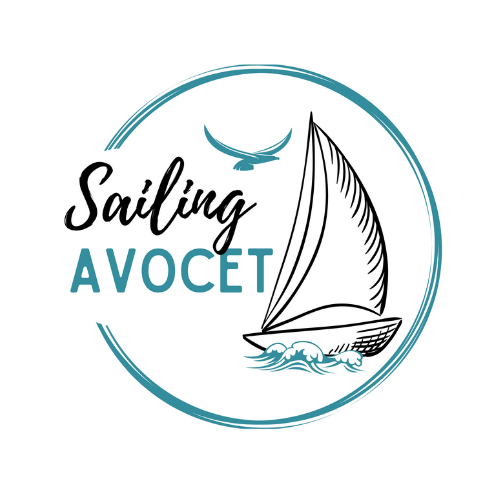






















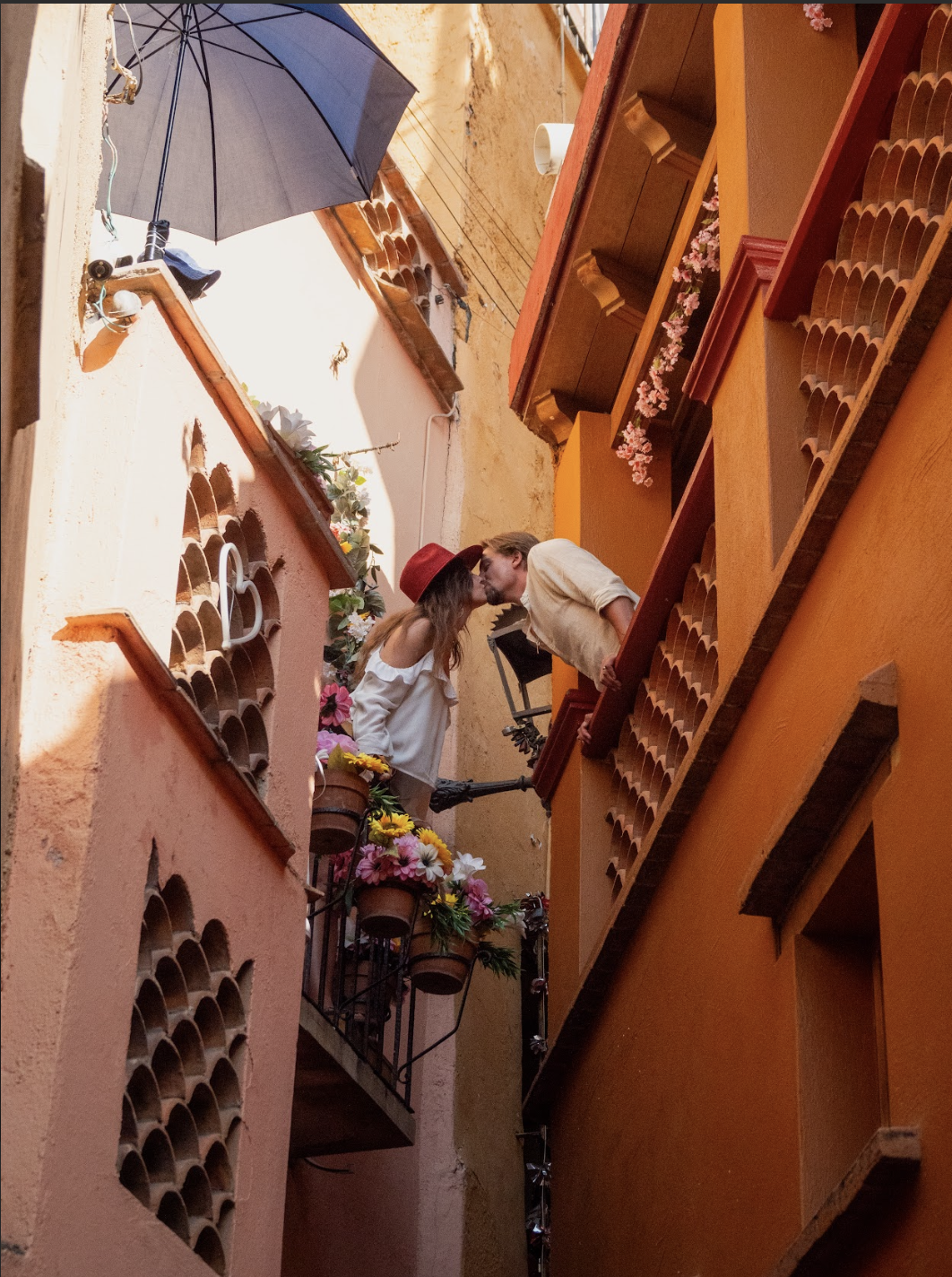

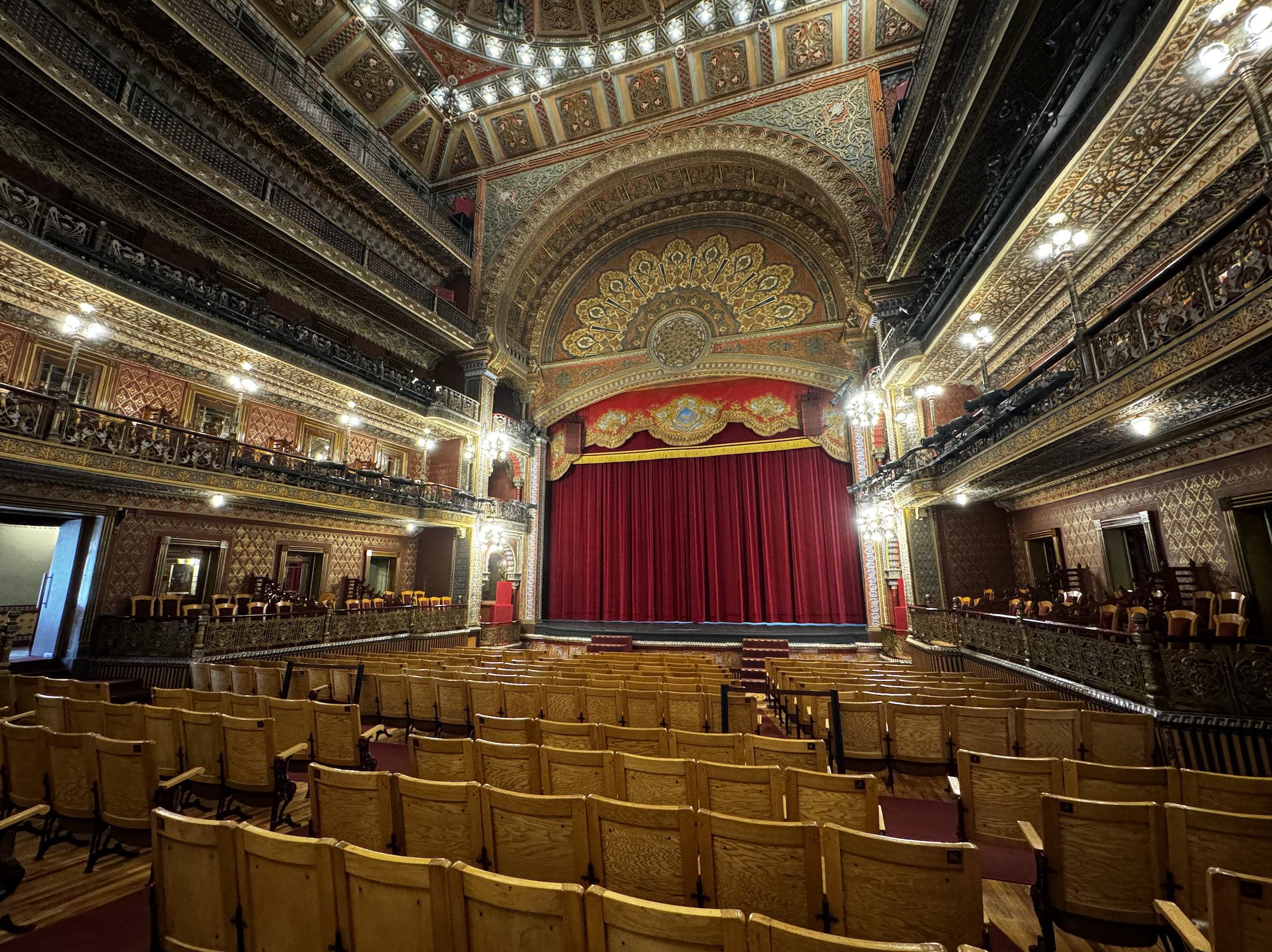



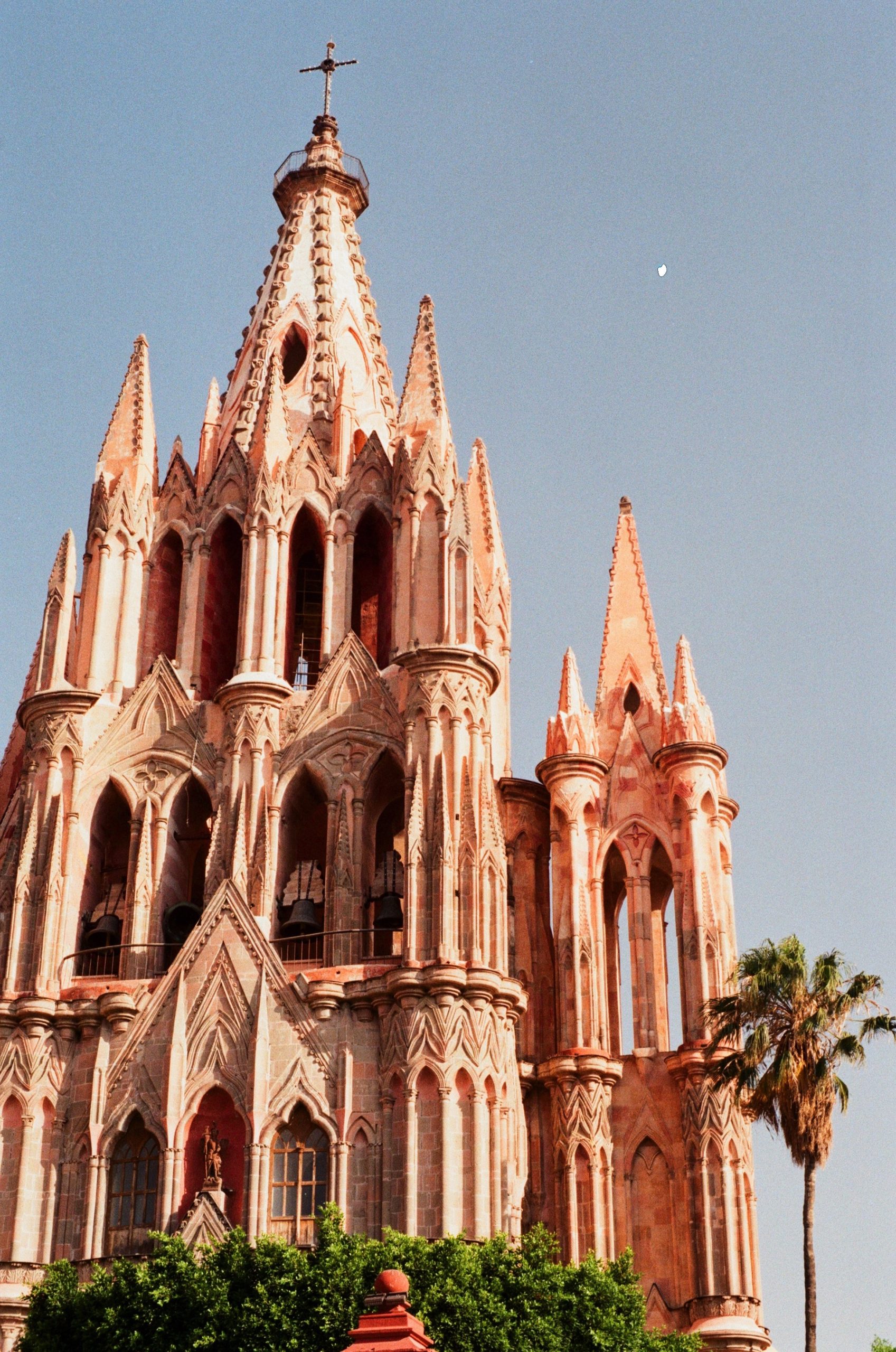

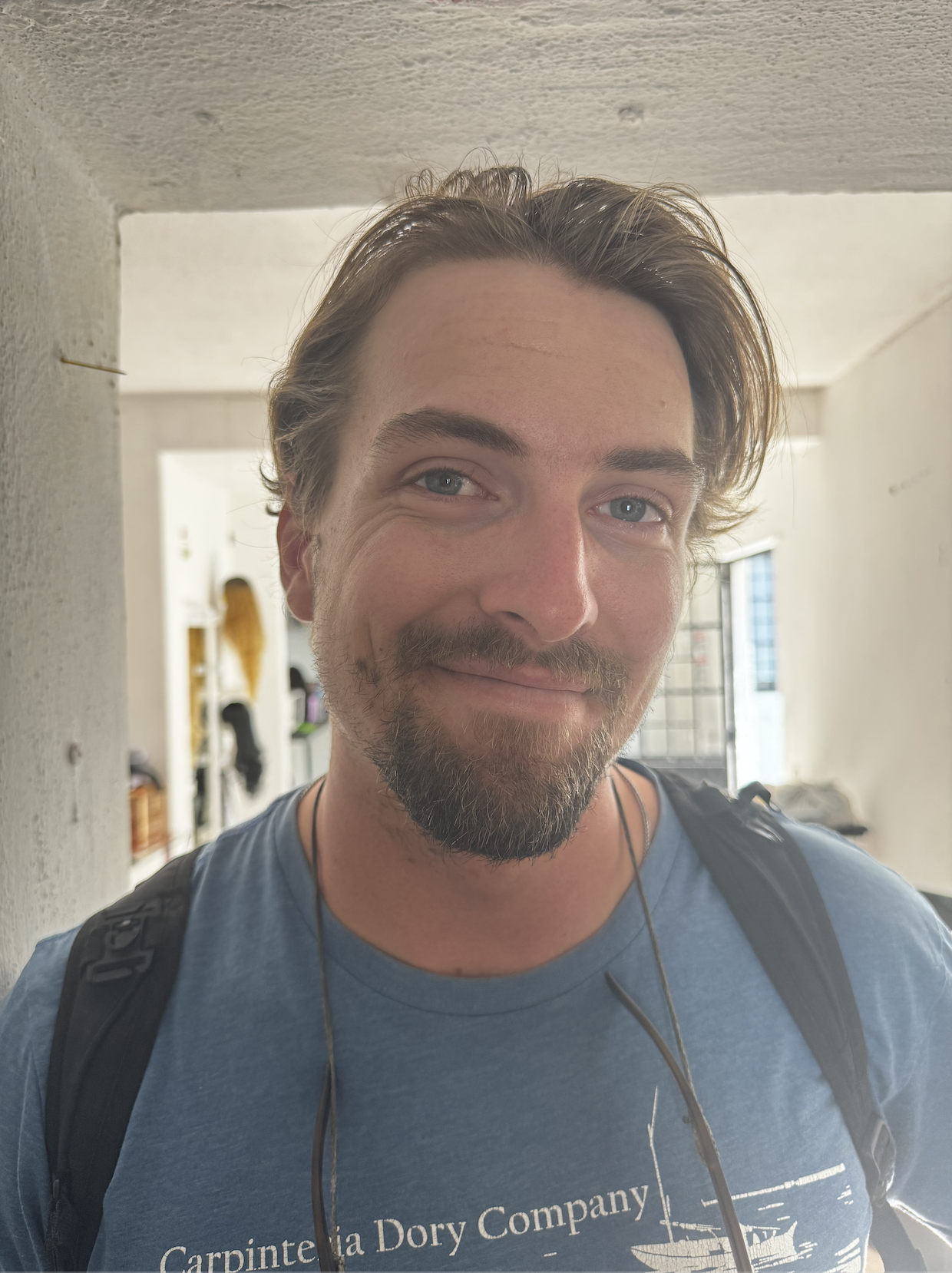
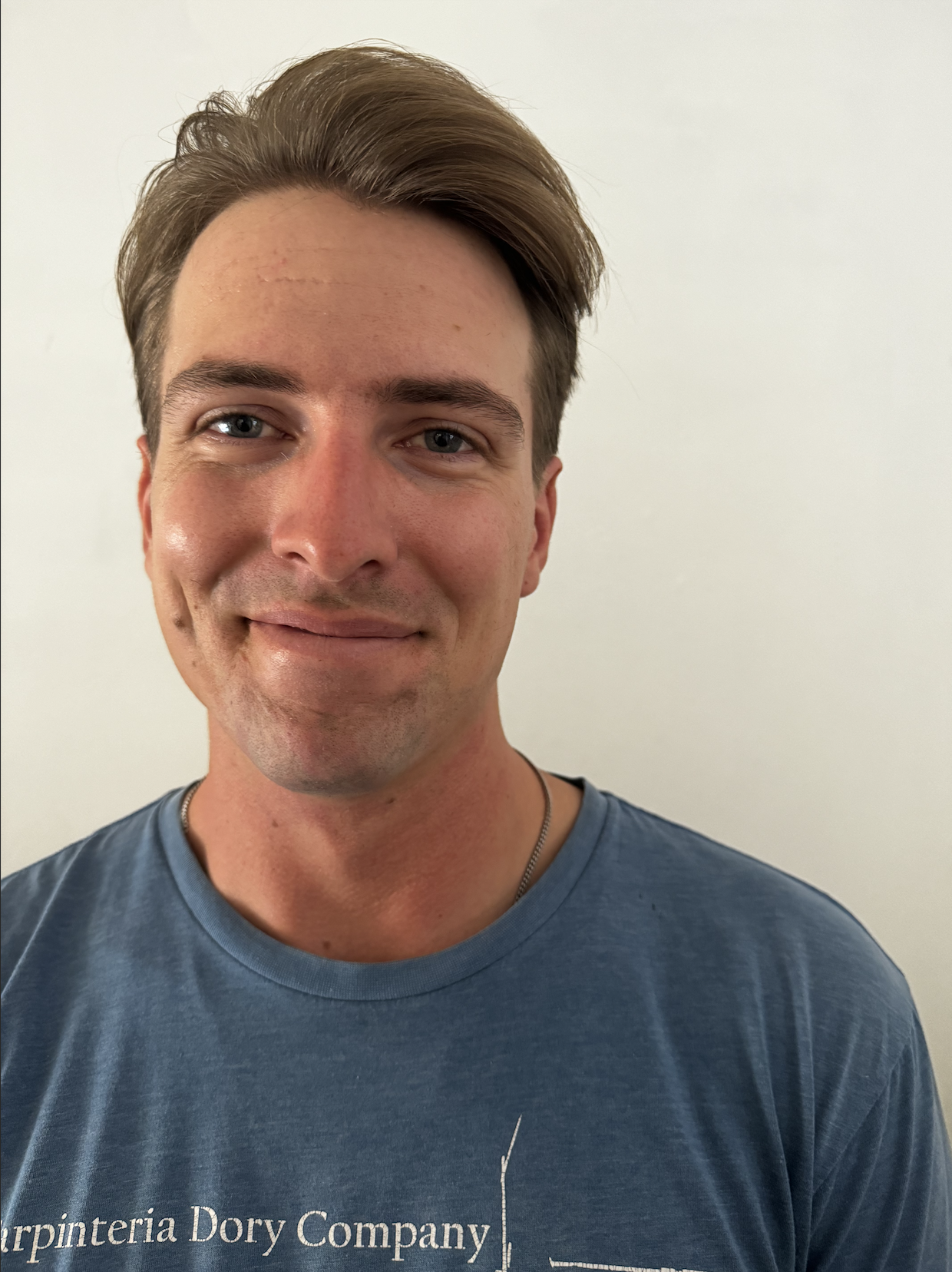





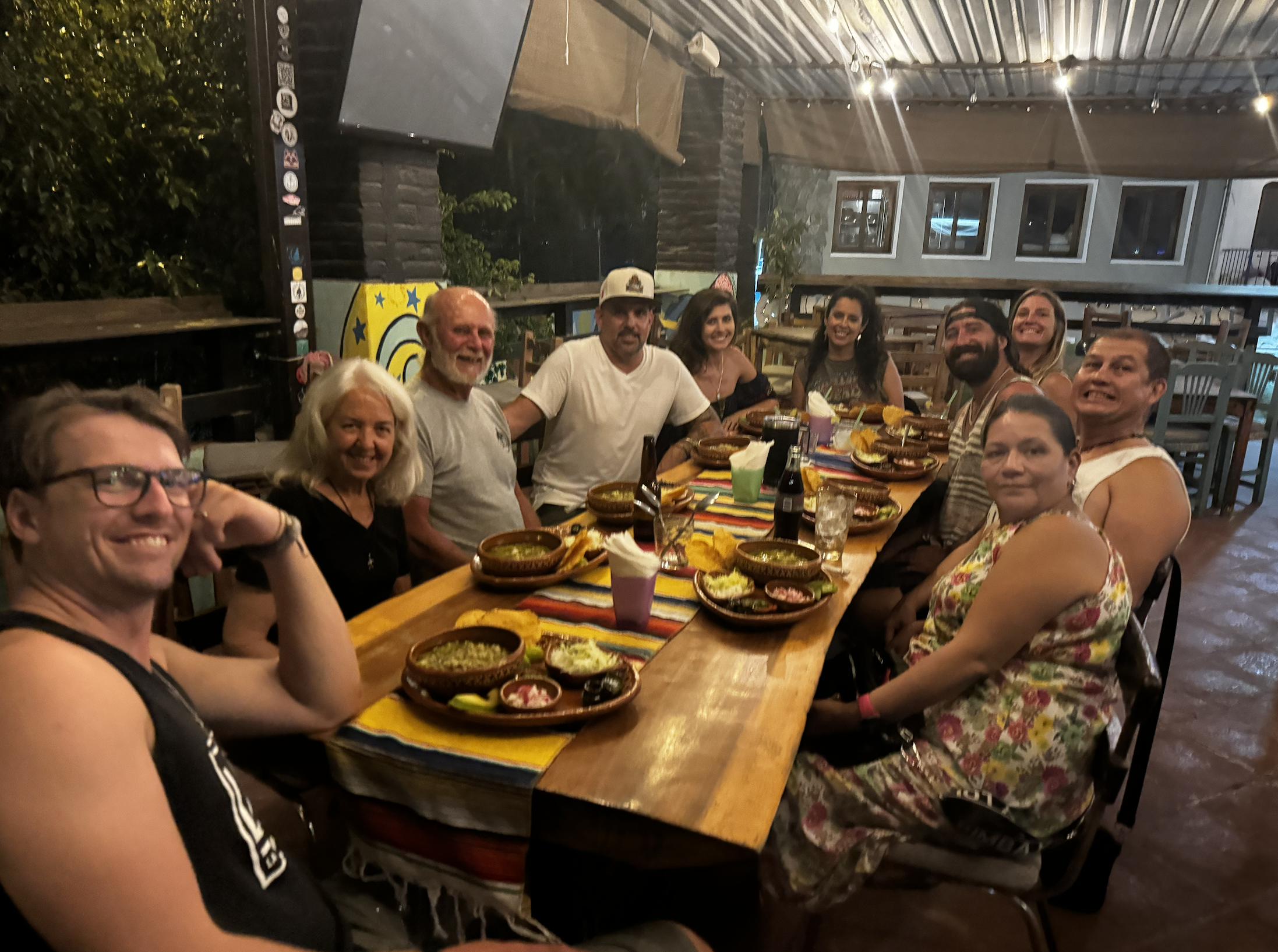
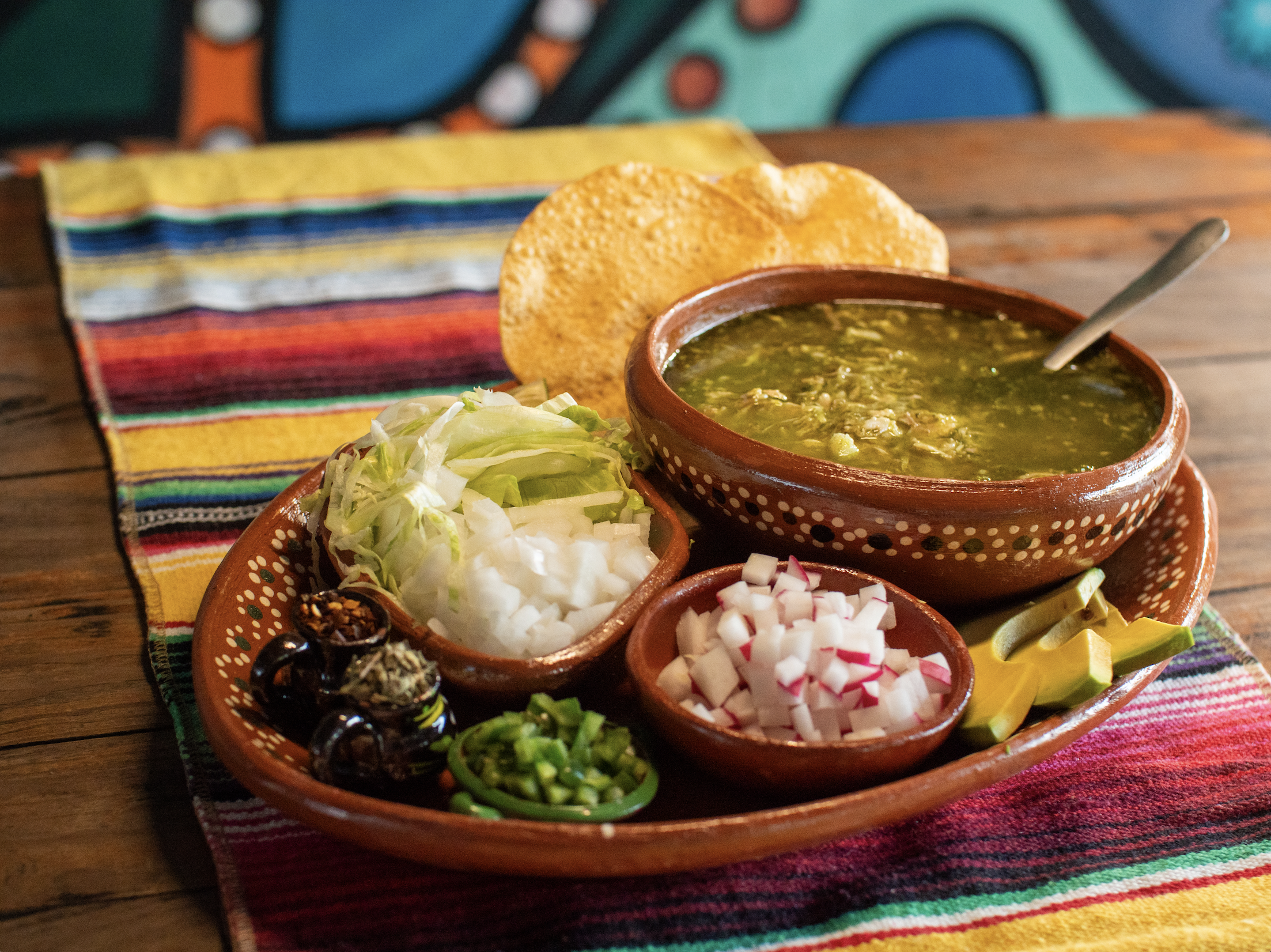


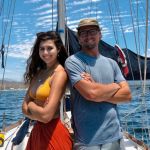

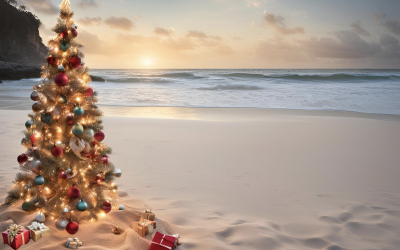

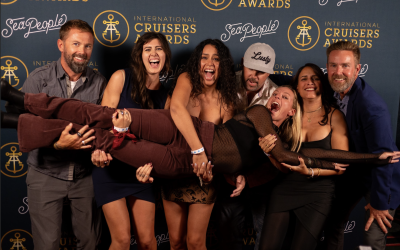
Vicarious love of the food via photo. Not sure about the words bull 🍆 though. And the fixing your clasp for 30 pesos, that’s a steal of a deal. How much did the barber charge for Chris?
So much food! I think it was $25 USD for the barber – she was sweet, didn’t speak a lick of English and looked tough as nails.